Remember when Disney released Song of the South? It takes place during the Reconstruction Era, and the story encompasses a seven-year old Caucasian boy establishing a friendship with a nice, old African-American man who joyfully tells the stories of B’rer Rabbit, B’rer Fox and B’rer Bear. Many critics have opined that this film is “racist” and “offensive”, but I don’t buy that. Honestly, it’s one of my favorite live-action Disney movies, along with Mary Poppins, The Parent Trap (both the original and the remake), Honey, I Shrunk the Kids, Cool Runnings and Brink! Today’s movie is very controversial, even before it got released, because of its use of racial stereotypes. I am of course talking about the 1975 Ralph Bakshi film, Coonskin.
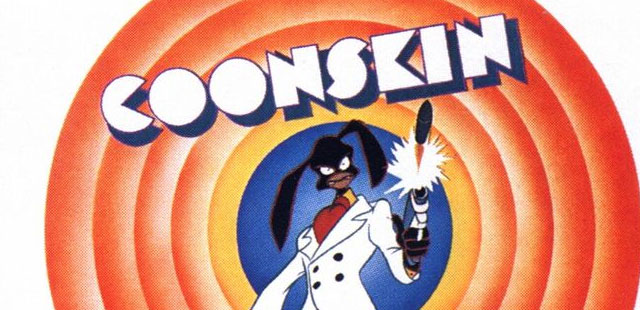
Before I review this movie, let’s get one thing out of the way: I despise racism. Even though racism isn’t as prevalent now as it was during the 20th Century, there are acts of racism happening every day. Even when I was a little boy, I’d establish friendships with people of all races, because my parents helped me instill the value of treating others the same way I’d want to be treated, and to treat people with respect. I am very fortunate to be friends with people of all races – not just African-Americans, but also Hispanic and Latino-Americans, Middle Eastern-Americans, Native-Americans, Asian-Americans, Indian-Americans and even Caucasian-Americans. I’m a huge fan of funk music and old school hip hop, and most of those musicians making this music were of African descent. Naturally, Coonskin is my favorite Ralph Bakshi film, and it’s not even because of its depiction of African-American culture, but because it illustrates how the days of black oppression are over, and how they shouldn’t be treated like property. Now that I mentioned it, I think it’s absolutely ridiculous that college athletic apparel has “Property of [insert college name] Athletics” written all over their shirts, seeing how most of the athletes on college football and basketball teams are predominantly black.
As I mentioned in my Heavy Traffic review, Bakshi grew up in many different neighborhoods around New York City, but he was very fond of the time spent in a predominantly black neighborhood. These people tremendously impacted Bakshi’s life, and inspired Bakshi to make a movie encompassing African-American culture.
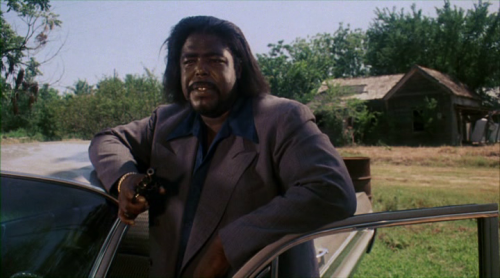
Anyway, let’s get to the actual movie. This movie is a satire on the Uncle Remus stories, and heavily inspired by Song of the South. The story is told via a frame story, seeing how the beginning and end scenes are entirely filmed in live-action, and the middle portion is essentially a live-action/animation hybrid. The movie begins with Sampson (played by Barry White) and the local Preacher Man (played by Charles Gordone) busting out their friend Randy (played by Philip Michael Thomas) from prison. Before Sampson and the Preacher Man arrive, Randy and another cellmate, Pappy (played by Scatman Crothers) escape from inside the prison and Pappy begins his story. Here, the movie shifts from live-action to animation.
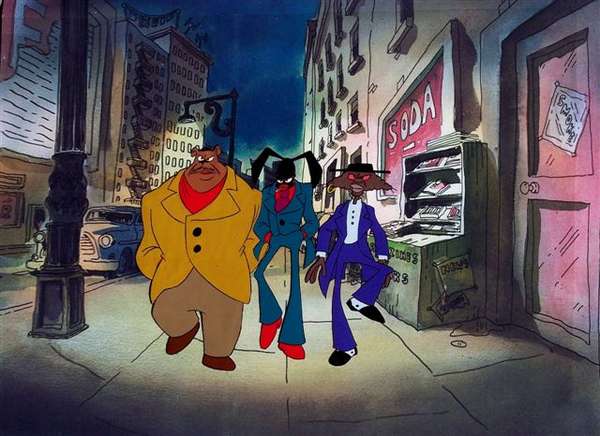
The “story” centers around three characters: Brother Rabbit (voiced by Philip Michael Thomas), Brother Bear (voiced by Barry White) and Preacher Fox (voiced by Charles Gordone), relocating to Harlem, only to find out that it’s a total wasteland after learning that the white mafia and drug dealers run this neighborhood. When the trio arrive in Harlem, Brother Rabbit decides that he’s gonna take control of the mafia, because even he knows that racism is just a bunch of bullshit. Brother Rabbit deals with a virulently racist and homophobic police officer named Madigan, and a grotesque version of the Godfather. Continuity game on fleek. Bakshi recreates The Godfather as a grotesque, Jabba the Hutt-like creature, and he is voiced by Al Lewis, who played Grandpa on the CBS television show The Munsters.

Out of all the Bakshi films I’ve seen, this movie has the best cast of characters. What do we know about Fritz? He’s kind of admirable, but he’s also a bit of a moron. What about Michael? He’s normal compared to most of the characters in Heavy Traffic, but there’s nothing spectacular about him. How about Brother Rabbit? Honestly, he is just badass. He’s very smart, confident and cunning. He knows what he wants and is determined to get it. Philip Michael Thomas, who you may recognize as Ricardo Tubbs from the ‘80s crime drama Miami Vice, does a fantastic job voicing this character. “I’m tired of trying to segregate, integrate and masturbate any more. The longer we wait, the longer we’re gonna end up like Malcolm and King did.” Come to think of it, Coonskin is one of the few Bakshi films that has a cast of recognizable voice actors. You’ve got Philip Michael Thomas voicing Brother Rabbit, Barry White voicing Brother Bear, Scatman Crothers voicing Pappy and Al Lewis voicing the Godfather.

Even though Bakshi adopts Disney’s strategy of integrating animation with live-action, it’s clear from the film’s prologue that this film is intended for an adult audience. In lieu of friendly bluebirds jauntily perching on one’s shoulders, we get a quick and dirty repartee from a couple of wisecracking, N-word dropping cartoon animals. Oddly enough, much of the film’s stereotyping is difficult to swallow; and they not only villainize African-Americans as gangsters, but they demean women too. In the film’s most fully realized allegory, Miss America is depicted as a nude, big-breasted, blonde-haired white giantess covered in stars and stripes who alternately cock-teases and drop-kicks her diminutive black pimp. It’s a bizarre recasting of the Wiley Coyote/Road Runner relationship that is both bluntly satirical and pointlessly degrading. Even though this film was very good, the number of stereotypes I observed within this movie were more than I could handle. Since the main characters of the movie are African-Americans, they naturally use the N-word. Needless to say, I was offended by it. I realize this is a satire on African-American culture, but come on, this film could’ve been a little less offensive than it already is.

Before this film was released in 1975, people were already protesting this movie because of its depiction of racial stereotypes. This film was originally going to be distributed by Paramount Pictures, but they eventually refused after receiving backlash from black protesters, selling the movie to Bryanston as an attack on the system. It’s not like this is the first time something like that ever happened on behalf of a Ralph Bakshi movie. Bakshi’s 1972 film Fritz the Cat was originally going to be distributed by Warner Brothers, but they eventually pulled the plug after noticing immense sexual content.
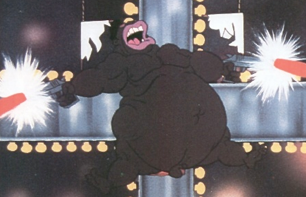
In all honesty, it was kind of cool seeing Bakshi hop on the bandwagon by giving us a slice of life of African-American culture. Blaxploitation films and movies consisting of a predominantly African-American cast were ubiquitous in the seventies. 1971 gave us the movie Shaft, containing an eclectic soundtrack recorded by the brilliant Isaac Hayes. 1972 gave us Super Fly, warranting a soundtrack done by Curtis Mayfield. Finally, in 1975, Ralph Bakshi released Coonskin. A year later, Michael Schultz (not to be confused with my BH brother) directed the 1976 comedy film Car Wash, starring Richard Pryor, Ivan Dixon and the Pointer Sisters. This movie was produced by Joel Schumacher, years before he directed the awful live-action Batman movies. Schumacher reunited with Pryor while writing the screenplay for the 1978 musical comedy The Wiz, an urban reimagining of The Wizard of Oz, containing an entirely African-American cast. It’s the 2010s and the most recent blaxploitation films out there are Undercover Brother and Black Dynamite.

When Coonskin was first screened at the Museum of Modern Art, the Congress of Racial Equality were offended by this film. People like Al Sharpton were already protesting this movie before it was theatrically released. The film was later shown at the Paramount Building in New York City, where CORE picketed this film. A handful of theaters showed this movie, and during one of those showings, some jackass threw a smoke bomb in there because he was offended by the racial stereotypes. Okay, I’m not entirely sure if it was a man or a woman who sabotaged the theater, but I’m gonna take a wild guess and assume that the perpetrator was a dude. Granted, this film contains a lot of offensive stereotypes about African-Americans, but their significance is essential to the film’s plot. These stereotypes demonstrate that the days of white oppression are gone and racism will either die or get annihilated, giving these offensive African-American stereotypes a good punch goodbye.
Despite Coonskin being an extremely controversial movie, this film has left a legacy. Many directors and critics have praised this movie for how it obliterates offensive stereotypes and how racism will become irrelevant in the future. Okay, racism is unfortunately still alive everywhere in this world, but I generally stay out of it, and if I ever catch anyone calling their African-American friend the N-word or purposely offending that person, I will run up to that person, grab him by the arms and tell him, “NOT COOL, YOU SHOULD KNOW BETTER THAN THAT!” I used to think that it was acceptable to use the N-word because one variation of that word is hip hop slang for a close friend or buddy. I listened to a lot of old school hip hop during my high school days, and I felt like there was nothing wrong with just a simple word. But now, I’m under the impression that anyone who utilizes that offensive word is either a bona fide racist or trying to be as racist as possible. This includes African-Americans utilizing that word. Excessive swearing makes you sophomoric. When I was much younger, I would occasionally call women “bitches”, realizing that they’d only be offended purely because of the stigma. As time progressed, they miraculously forgave me, because I obviously didn’t know better back then, and we all go through a ridiculous phase where demeaning the opposite sex is a sign of coolness.
“A masterpiece.” – The New York Times
“Most incendiary work in the entire genre” – Quentin Tarantino
“Extraordinary and brilliantly realized.” – The Hollywood Reporter
“A film of brilliant devastation” – Gene Shalit
Seriously though, people like Roger Ebert and Spike Lee have praised this film because it’s one of the most imaginative films that has ever existed. The Wu-Tang Clan have expressed interest in making a sequel to Coonskin, and to be honest, I would be totally interested in seeing it, but maybe this film is good enough on its own.
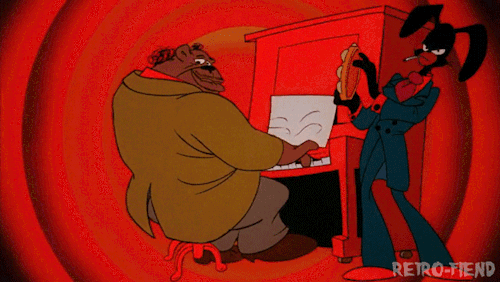
What I like about the movie:
- Just about everything.
- Philip Michael Thomas being the voice of Brother Rabbit.
- Barry White being the voice of Brother Bear.
- Charles Gordone being the voice of Preacher Fox.
- Miss America. She is so fucking gorgeous, and even sexier than Jessica Rabbit.
- Scatman Crothers being the voice of Pappy.
- Al Lewis being the voice of The Godfather.
- The integration of live-action and animation is fucking amazing. This movie predates Roger Rabbit by 13 years, and it’s done flawlessly.
- How African-American stereotypes are utilized to show that the days of white oppression are over and not utilized to offend audiences.
- Brother Rabbit being a badass, confident, and smart character.
- How this movie is basically Bakshi’s answer to the controversial Disney movie Song of the South, since the inspiration for both of these sources of media were the Uncle Remus stories.
What I dislike about the movie:
- Some of the stereotypes within this movie are kind of offensive.
- The fact that this film was receiving controversy before it was released. To add insult to injury, a movie theater showing this movie was bombarded with a smoke bomb.
- Too many people hate on this film.
- Some scenes involving the characters being integrated with dark backgrounds. I realize that this is a nocturnal film, and Bakshi has admitted that he can conceal so many things at night, but when your main character is entirely black, the illusion fails.
Cultural references:
- The entire story of “Coonskin” is an homage to the Uncle Remus stories, made famous by the Disney film Song of the South, which also integrates live-action with animation. All three characters: Br’er Bear, Br’er Rabbit and Br’er Fox, lend their names from these stories.
- The characters, Malcolm the Cockroach, and Ignatz the Mouse, pay tribute to legendary animator George Herriman. Malcolm the Cockroach’s name is an homage to Malcolm X.
- Bakshi grotesquely depicts The Godfather as a greedy slob.
- A con man named Simple Savior, who claims to be the cousin of “Black Jesus” (I’m pretty sure Jesus was born in Israel and is of Middle Eastern descent) destroys images of John Wayne, Elvis Presley and Richard Nixon.


